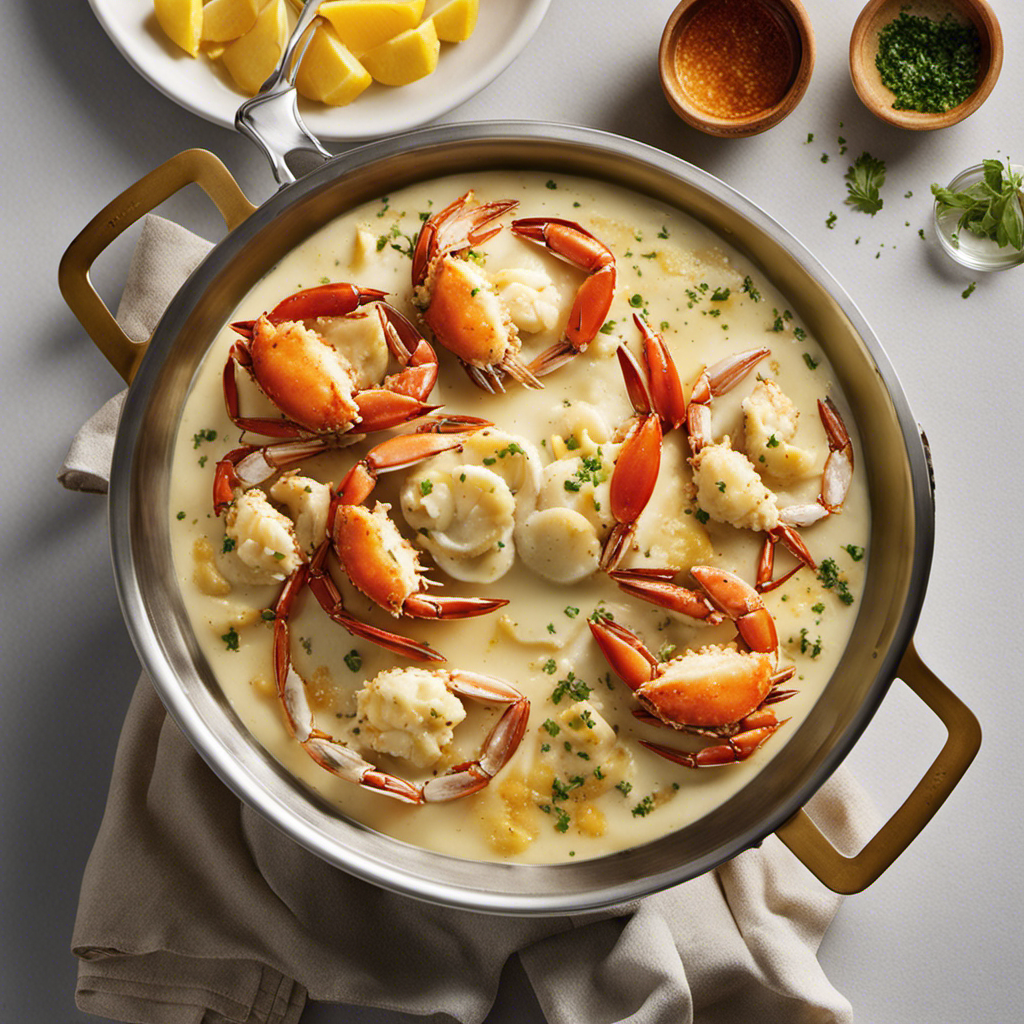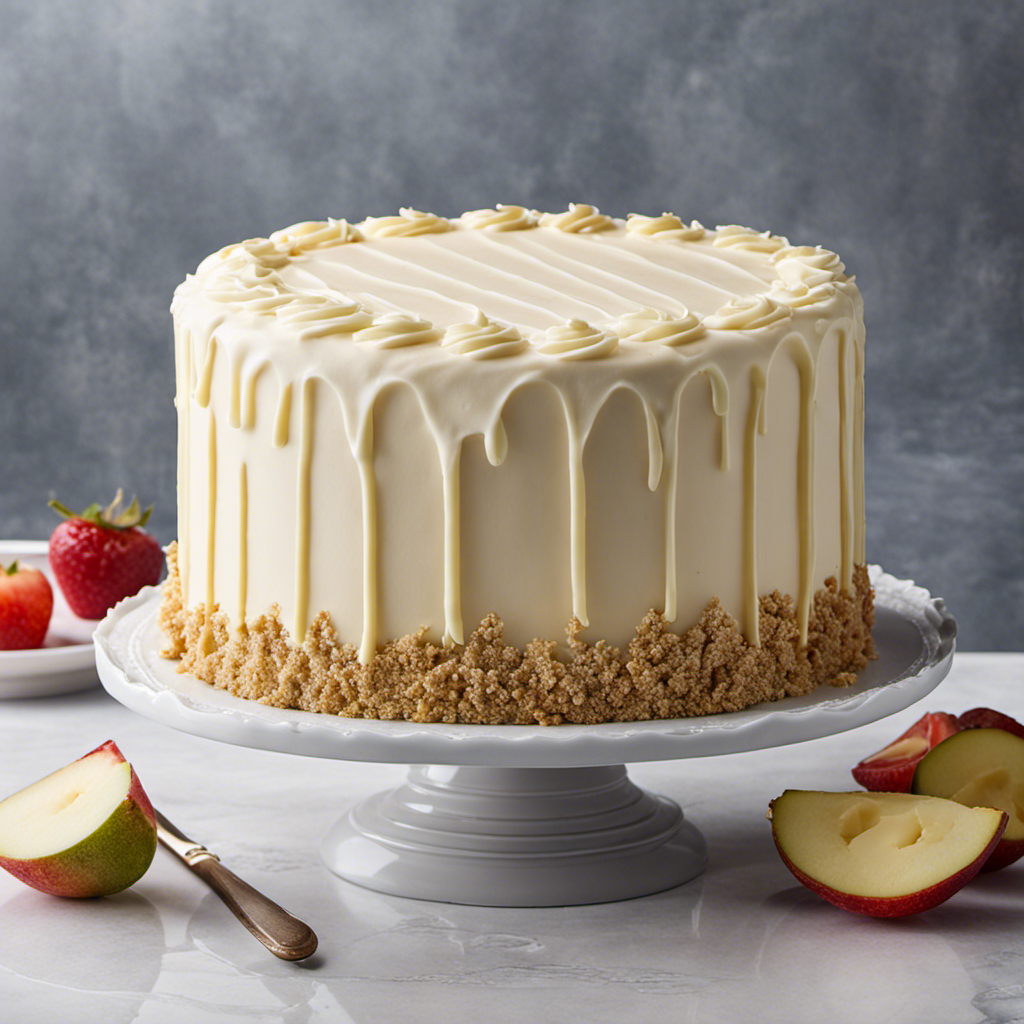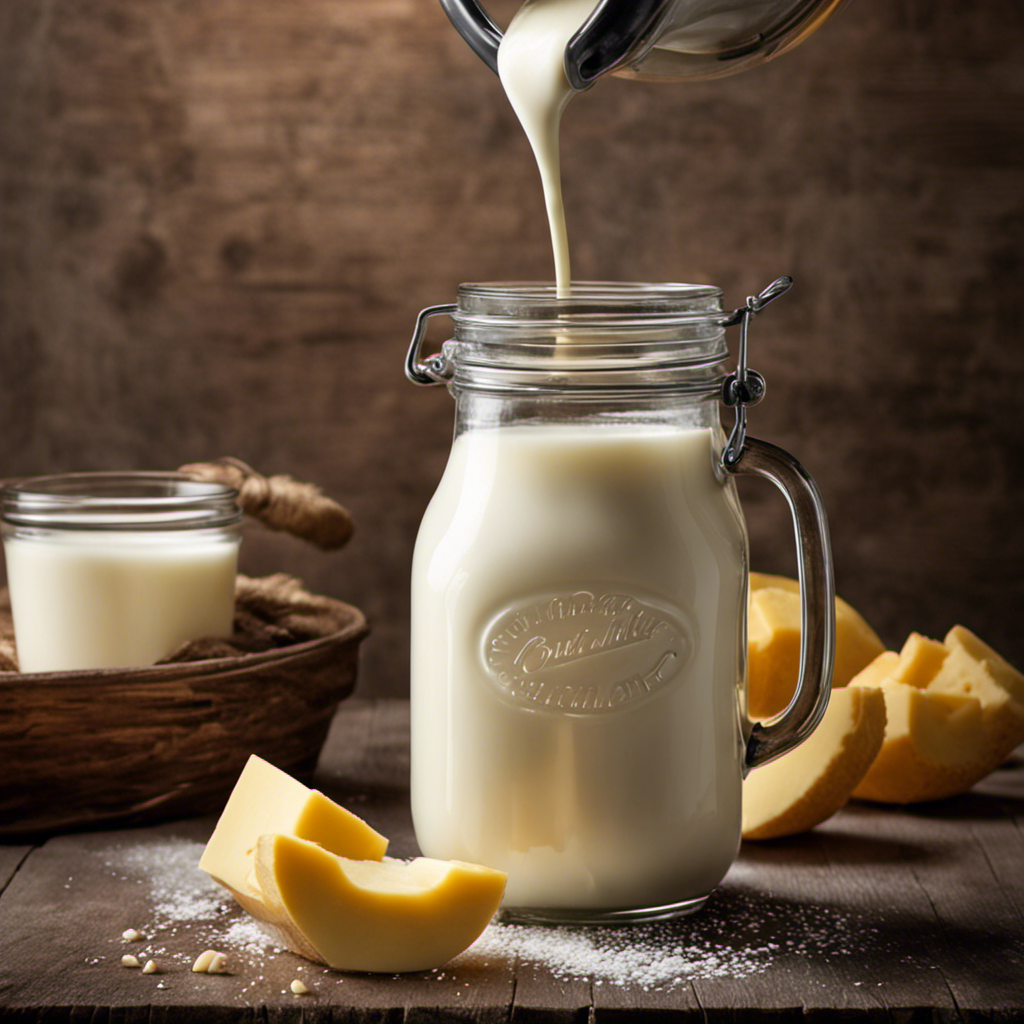As I explore the realm of delicious cuisine, I am always on the lookout for new flavors to excite my palate. Today, I welcome you to come along with me as we embark on a culinary adventure to make a delectable dish: crab butter sauce.
This delectable concoction, with its creamy texture and rich flavor, is the perfect accompaniment to any seafood dish. So, grab your apron and let’s embark on this culinary adventure together.
Trust me, once you taste this heavenly sauce, you’ll never look back.
Key Takeaways
- Choosing the right crab is important, with smaller crabs like blue crabs being ideal for butter sauce.
- Fresh crab offers a sweet and delicate flavor that can’t be replicated, while canned crab is a convenient alternative.
- Different cooking methods such as boiling, steaming, grilling, or sautéing can be used for crab, each bringing out different flavors.
- Adjusting the seasoning and experimenting with flavor variations can enhance the overall experience of making crab butter sauce.
Choosing the Right Crab
Now, you’ll want to make sure you’re choosing the right crab for your butter sauce. When it comes to selecting the perfect crab, there are a few factors you should consider.
The first one is the size of the crab. Smaller crabs, like blue crabs, are ideal for butter sauce as they have a delicate and sweet flavor that pairs well with the richness of the sauce. On the other hand, larger crabs, such as Dungeness or king crabs, have a more robust flavor that can overpower the sauce.
Another important aspect to consider is the different crab species. Each species has its own unique taste and texture, so it’s worth trying out different varieties to find your favorite. Whether you prefer the sweet and tender meat of a blue crab or the meaty richness of a Dungeness crab, choosing the right crab will elevate your butter sauce to a whole new level of deliciousness.
Preparing the Crab Meat
When it comes to preparing crab meat, one of the first decisions you’ll need to make is whether to use fresh or canned crab.
Fresh crab is always my preferred choice, as it offers a sweet and delicate flavor that simply can’t be replicated. However, if fresh crab is not available or you’re looking for a more convenient option, canned crab can still be a great alternative.
Regardless of which type you choose, there are various cooking methods that can be employed to bring out the best flavors in crab, whether it’s steaming, boiling, grilling, or even sautéing.
Each method offers its own unique characteristics and allows you to explore the versatile nature of this delectable seafood.
Fresh or Canned Crab
If you’re in a hurry, you can use canned crab for the butter sauce instead of fresh crab. However, I highly recommend using fresh crab for a truly exquisite and flavorful experience.
Fresh crab has a delicate sweetness and a succulent texture that simply can’t be matched by its canned counterpart. There are different types of crab that you can choose from, each with its own unique taste.
The most popular ones include Dungeness, Blue, Snow, and King crab. Dungeness crab has a rich and buttery flavor, while Blue crab offers a sweet and slightly nutty taste. Snow crab has a delicate and sweet flavor, and King crab is known for its tender and juicy meat.
Cooking Methods for Crab
One popular cooking method for crab is boiling it in a large pot of salted water until it turns a vibrant orange color. This technique not only cooks the crab thoroughly, but also enhances its natural flavor.
As the crab boils, the salted water infuses into the meat, adding a subtle brininess that complements the delicate sweetness of the crab. The cooking time may vary depending on the size of the crab, but generally, it takes about 10-15 minutes.
Once cooked, you can enjoy the crab as is or use it as an ingredient in various dishes, such as crab cakes or crab bisque. Experimenting with different cooking techniques and flavor variations is what makes cooking crab such a delightful experience.
Gathering the Necessary Ingredients
When it comes to making a delicious sauce, the key ingredients are the backbone of any successful dish. From the rich and tangy flavors of tomatoes to the aromatic blend of herbs and spices, each component plays a vital role in creating a culinary masterpiece.
However, it’s not just about throwing everything together – preparing the ingredients properly is crucial in order to extract their maximum flavors and textures. And while it can be frustrating when a certain ingredient is unavailable, fear not, as there are plenty of alternatives that will still allow you to create a mouthwatering sauce that will leave your taste buds begging for more.
Key Ingredients for Sauce
The key ingredients for the crab butter sauce include butter, garlic, and lemon juice. These three elements come together to create a luscious and flavorful sauce that perfectly complements the delicate taste of crab.
However, if you’re feeling adventurous or simply don’t have all the ingredients on hand, don’t fret! There are plenty of options for substituting ingredients and creating variations of crab butter sauce.
For instance, if you’re not a fan of garlic, you can use shallots instead for a milder flavor. Additionally, you can experiment with different citrus fruits like lime or orange to add a unique twist to the sauce.
The possibilities are endless, and exploring these variations can elevate your crab dish to new heights of culinary delight.
Preparing Ingredients Properly
To properly prepare your ingredients, start by mincing the garlic and squeezing the lemon juice. These simple steps are crucial to infuse your crab butter sauce with bold flavors.
As a passionate chef, I understand the importance of properly marinating the crab meat to enhance its taste and texture. I recommend allowing the crab meat to sit in a marinade of garlic, lemon juice, and a pinch of salt for at least 30 minutes. This will ensure that every bite of crab is bursting with tangy and savory flavors.
When it comes to pairing sauces with crab butter sauce, there are endless possibilities. From a classic tartar sauce to a spicy sriracha mayo, the choice is yours. Experiment with different types of sauces to complement the richness of the crab butter sauce and elevate your dish to new heights.
Alternatives to Unavailable Ingredients
Now that we know how to properly prepare the ingredients for our crab butter sauce, let’s talk about alternatives to butter. Sometimes, butter may not be readily available or you may be looking for a healthier option. Thankfully, there are several substitutes for butter that can still give your sauce that rich and creamy texture. Here are three options to consider:
-
Olive oil: This heart-healthy oil adds a subtle fruity flavor to your sauce while keeping it light and smooth.
-
Coconut milk: For a tropical twist, coconut milk can be used as a dairy-free alternative. It brings a creamy and slightly sweet taste to the sauce.
-
Avocado: Mashed avocado works wonders as a butter substitute. Its creamy texture adds richness to the sauce and provides a dose of healthy fats.
In addition to exploring butter substitutes, don’t be afraid to experiment with different types of seafood in your sauce. Varieties like shrimp, lobster, or even scallops can bring unique flavors and textures to the table. So go ahead, get creative, and make your crab butter sauce truly exceptional.
Cooking the Butter Sauce Base
First, melt the butter in a saucepan and add the minced garlic.
As the butter slowly melts, the rich aroma of garlic fills the air, instantly awakening the senses.
This is where the magic begins, where the cooking techniques come into play.
I gently stir the garlic, making sure it doesn’t burn but releases its sweet, pungent flavor.
The butter begins to take on a golden hue, creating a luscious base for the crab butter sauce.
The possibilities for flavor variations are endless.
I could add a splash of lemon juice for a tangy twist, or a sprinkle of chili flakes for a touch of heat.
The cooking techniques and flavor variations are what make this butter sauce truly exceptional, elevating it from a simple condiment to a culinary masterpiece.
Adding the Crab Meat to the Sauce
As you stir in the tender crab meat, it effortlessly blends with the rich, golden sauce, creating a delectable combination of flavors. The addition of crab meat to the butter sauce takes this dish to a whole new level.
Here are three things you need to know about crab meat storage and the different types available:
-
Storage: Fresh crab meat should be refrigerated and consumed within two days. If you’re using canned crab meat, it can be stored for up to a year in a cool, dry place.
-
Types: There are two main types of crab meat: lump and claw. Lump crab meat comes from the larger muscles of the crab and has a sweet, delicate flavor. Claw meat comes from the smaller claws and has a slightly stronger taste.
-
Varieties: Blue crab, Dungeness crab, and snow crab are some popular varieties of crab meat used in cooking. Each variety has its own unique taste and texture.
Now that the crab meat is incorporated into the sauce, it’s time to adjust the seasoning to enhance the flavors even further.
Adjusting the Seasoning
Once the crab meat is blended with the sauce, you can enhance the flavors even further by adjusting the seasoning. Modifying the spice level and experimenting with different herbs can take your crab butter sauce to the next level of deliciousness. Here’s a table to help you navigate the world of seasoning options:
| Spice Level | Herbs | Flavor Profile |
|---|---|---|
| Mild | Parsley | Fresh and light |
| Medium | Thyme | Earthy and aromatic |
| Spicy | Cayenne pepper | Fiery and bold |
| Extra Spicy | Basil | Zesty and vibrant |
| Custom | Your choice! | Get creative |
Serving and Enjoying the Crab Butter Sauce
To fully enjoy the crab butter sauce, drizzle it over a plate of freshly steamed crab legs and savor every flavorful bite. The rich and creamy texture of the sauce complements the sweetness of the crab, creating a match made in seafood heaven.
Here are some serving suggestions and pairings that will elevate your crab butter sauce experience:
- Spread the sauce generously on toasted baguette slices and serve as an appetizer.
- Pair the sauce with grilled shrimp for a delectable surf and turf dish.
- Use the sauce as a dip for crispy calamari or fried oysters.
The possibilities are endless when it comes to enjoying this decadent sauce. Its smooth and velvety consistency enhances the natural flavors of any seafood dish. So go ahead, indulge in the lusciousness of crab butter sauce and let your taste buds dance with delight.
Frequently Asked Questions
Can I Use Canned Crab Meat Instead of Fresh Crab Meat?
Sure, you can definitely use canned crab meat as a substitute for fresh crab meat in crab butter sauce. While fresh crab may have a slightly better flavor and texture, canned crab can still work well and provide a tasty outcome.
How Long Should I Cook the Butter Sauce Base For?
Cook the butter sauce base until it’s velvety and fragrant, stirring constantly. The cooking time depends on the recipe variations, but aim for about 5-7 minutes. Trust me, the flavors will meld beautifully.
Can I Substitute the Butter With Margarine or a Different Type of Oil?
Sure, you can substitute butter with margarine or a different type of oil in crab butter sauce. However, keep in mind that it might alter the flavor and texture. Butter adds richness, while other oils may provide a different taste profile.
Is It Necessary to Strain the Sauce Before Adding the Crab Meat?
Straining the sauce before adding crab meat is a personal preference. Some argue it adds a smoother texture, while others enjoy the rustic feel. As for alternative ingredients, margarine or different oils can be used, though it may alter the taste slightly.
Can I Store Leftover Crab Butter Sauce in the Refrigerator and Reheat It Later?
Yes, you can definitely store leftover crab butter sauce in the refrigerator and reheat it later. It’s a convenient way to enjoy the delicious flavors again without any hassle.
Conclusion
In conclusion, making crab butter sauce is a culinary adventure that will transport your taste buds to a world of indulgence.
As I devoured the rich and velvety sauce, my senses were overwhelmed with the flavors of succulent crab meat and the decadence of butter.
Each bite was a symphony of textures and tastes, leaving me craving for more.
So, gather your ingredients, unleash your inner chef, and let this timeless recipe take you on a gastronomic journey like no other.
Get ready to savor the buttery ecstasy of this delectable sauce and indulge in a moment of pure culinary bliss.









